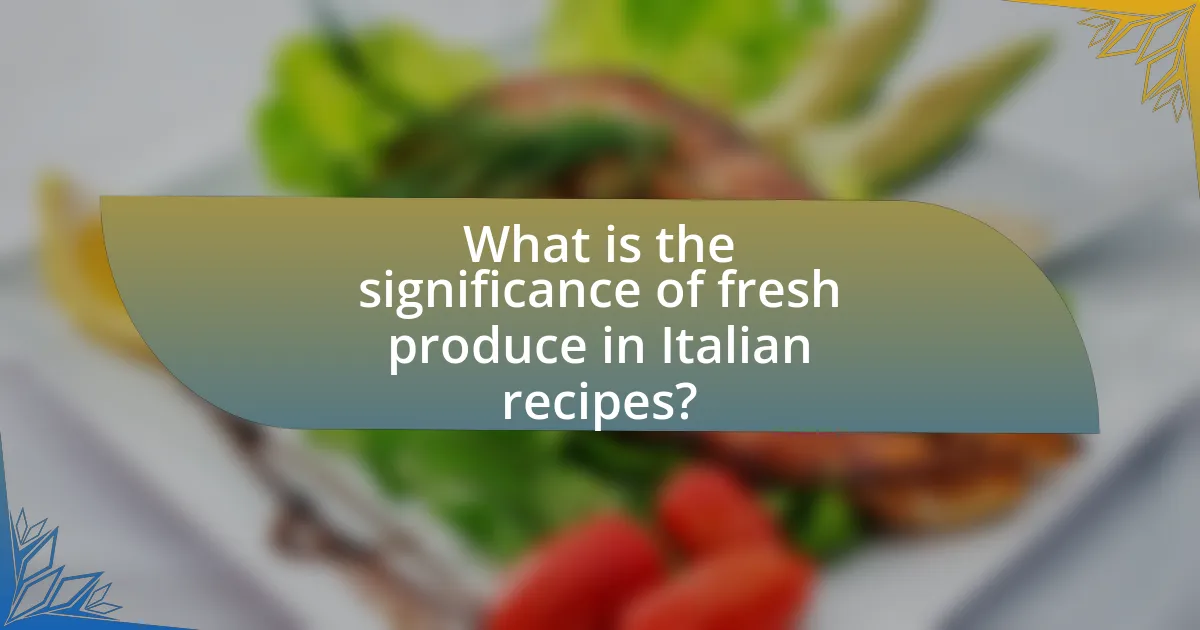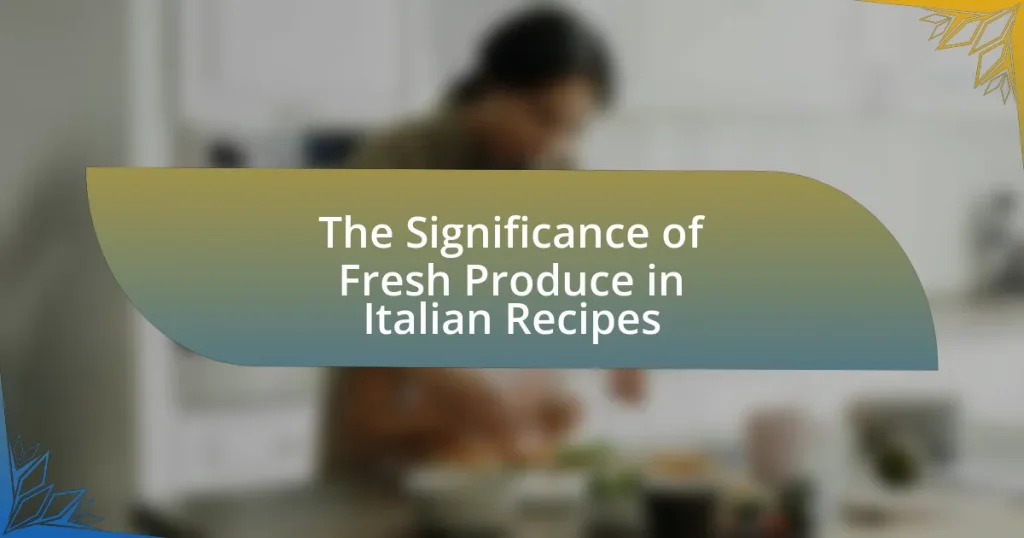Fresh produce plays a crucial role in Italian recipes, enhancing flavor, promoting health, and reflecting the country’s culinary traditions. The article explores the significance of using seasonal and local ingredients, such as tomatoes, basil, and olive oil, which are foundational to Italian cuisine. It discusses how the quality and freshness of produce impact the taste and nutritional value of dishes, emphasizing the importance of selecting high-quality ingredients. Additionally, the article highlights popular Italian recipes that showcase fresh produce and offers practical tips for maintaining ingredient freshness at home. Overall, the reliance on fresh produce is integral to the authenticity and vibrancy of Italian cooking.

What is the significance of fresh produce in Italian recipes?
Fresh produce is essential in Italian recipes because it enhances flavor, promotes health, and reflects the culinary tradition of Italy. The use of seasonal and local ingredients, such as tomatoes, basil, and olive oil, is a hallmark of Italian cuisine, ensuring that dishes are vibrant and full of natural taste. Historical practices in Italy emphasize the importance of fresh ingredients, as seen in the Mediterranean diet, which is recognized for its health benefits, including reduced risk of chronic diseases. This reliance on fresh produce not only elevates the quality of the food but also supports local agriculture and sustainability.
Why is fresh produce essential in Italian cuisine?
Fresh produce is essential in Italian cuisine because it enhances flavor, promotes health, and reflects regional diversity. The use of seasonal ingredients ensures that dishes are vibrant and full of taste, as fresh tomatoes, basil, and olive oil are foundational to many classic recipes. Additionally, Italy’s culinary tradition emphasizes the importance of local sourcing, which not only supports farmers but also guarantees the quality and freshness of the ingredients used. This commitment to fresh produce is evident in iconic dishes like Caprese salad and pasta sauces, where the quality of each ingredient directly impacts the overall dish.
What role does seasonality play in the use of fresh produce?
Seasonality significantly influences the use of fresh produce by determining the availability and quality of fruits and vegetables throughout the year. Seasonal produce tends to be fresher, more flavorful, and nutritionally superior, as it is harvested at its peak ripeness. For instance, tomatoes are typically in season during the summer months in Italy, leading to their prominent use in traditional dishes like Caprese salad and marinara sauce. This reliance on seasonal ingredients not only enhances the taste and authenticity of Italian recipes but also supports local agriculture and reduces environmental impact by minimizing transportation needs.
How does fresh produce enhance the flavors of Italian dishes?
Fresh produce enhances the flavors of Italian dishes by providing vibrant, natural tastes and essential nutrients that elevate the overall culinary experience. Ingredients such as ripe tomatoes, fragrant basil, and crisp vegetables contribute to the authenticity and depth of flavor characteristic of Italian cuisine. For instance, the use of fresh tomatoes in sauces results in a sweeter, more complex flavor profile compared to canned alternatives, as they contain higher levels of natural sugars and acids. Additionally, fresh herbs like basil and oregano release essential oils that intensify the aroma and taste of dishes, making them more appealing. Studies have shown that fresh produce retains more vitamins and minerals, which not only boosts flavor but also enhances the nutritional value of meals, aligning with the Mediterranean diet’s emphasis on healthful eating.
What types of fresh produce are commonly used in Italian recipes?
Commonly used fresh produce in Italian recipes includes tomatoes, basil, garlic, onions, bell peppers, zucchini, and eggplant. These ingredients are foundational in many traditional dishes, such as pasta sauces, salads, and vegetable medleys. For instance, tomatoes are essential for sauces like marinara, while basil is a key herb in pesto. Garlic and onions provide aromatic bases for various recipes, enhancing flavor profiles. The use of seasonal vegetables like zucchini and eggplant reflects the Italian emphasis on fresh, local produce, which is integral to the Mediterranean diet.
Which vegetables are staples in Italian cooking?
Tomatoes, garlic, onions, bell peppers, and zucchini are staples in Italian cooking. These vegetables form the foundation of many traditional Italian dishes, such as pasta sauces, risottos, and vegetable-based sides. For instance, tomatoes are essential for sauces like marinara and pomodoro, while garlic and onions provide aromatic bases for countless recipes. The use of these vegetables highlights the importance of fresh produce in Italian cuisine, emphasizing flavors and seasonal ingredients.
What fruits are frequently incorporated into Italian dishes?
Fruits frequently incorporated into Italian dishes include tomatoes, olives, lemons, and figs. Tomatoes are a staple in sauces and salads, while olives are essential for olive oil and tapenade. Lemons add brightness to dishes like risotto and seafood, and figs are often used in desserts and salads. The use of these fruits highlights the importance of fresh produce in Italian cuisine, contributing to flavor and authenticity.
How does the quality of fresh produce impact Italian recipes?
The quality of fresh produce significantly impacts Italian recipes by enhancing flavor, texture, and nutritional value. High-quality ingredients, such as ripe tomatoes, fresh basil, and seasonal vegetables, contribute to the authentic taste that characterizes traditional Italian cuisine. For instance, a study published in the Journal of Agricultural and Food Chemistry found that the flavor compounds in tomatoes are more pronounced when harvested at peak ripeness, directly influencing the overall taste of dishes like marinara sauce. Additionally, fresh produce retains more nutrients, which not only benefits health but also elevates the culinary experience, making the dishes more vibrant and appealing.
What are the characteristics of high-quality fresh produce?
High-quality fresh produce is characterized by vibrant color, firmness, and a pleasant aroma. Vibrant color indicates ripeness and nutrient density, while firmness suggests freshness and proper handling. A pleasant aroma is a sign of flavor and freshness, often associated with peak ripeness. Additionally, high-quality produce is free from blemishes, bruises, or signs of decay, which can indicate poor quality or improper storage. These characteristics are essential for enhancing the flavors and nutritional value in Italian recipes, where fresh ingredients play a crucial role in the overall dish quality.
How can the freshness of ingredients alter the final dish?
Freshness of ingredients significantly enhances the flavor, texture, and nutritional value of a final dish. Fresh ingredients, such as herbs, vegetables, and meats, contain higher levels of essential oils and nutrients, which contribute to a more vibrant taste and aroma. For instance, a study published in the Journal of Food Science found that fresh basil has a more potent flavor profile compared to dried basil, impacting the overall taste of Italian dishes like pesto. Additionally, fresh produce retains its crispness and juiciness, which improves the dish’s texture, making it more appealing. Therefore, using fresh ingredients is crucial in Italian recipes to achieve authentic flavors and optimal quality.
How do fresh ingredients influence traditional Italian cooking methods?
Fresh ingredients are fundamental to traditional Italian cooking methods, as they enhance flavor, texture, and nutritional value. The emphasis on using seasonal and locally sourced produce allows for the preparation of dishes that reflect the region’s terroir, resulting in authentic and vibrant flavors. For instance, the use of ripe tomatoes in sauces or fresh basil in pesto showcases how fresh ingredients can elevate simple recipes into culinary masterpieces. Additionally, traditional Italian cooking often involves techniques such as sautéing, roasting, or grilling, which are optimized when using high-quality, fresh ingredients, ensuring that the natural flavors are preserved and highlighted. This approach not only respects the ingredients but also aligns with Italy’s culinary philosophy of simplicity and quality.
What are the best practices for selecting fresh produce for Italian recipes?
To select fresh produce for Italian recipes, prioritize seasonal and locally sourced ingredients. Seasonal produce is typically fresher, more flavorful, and nutrient-rich, enhancing the authenticity of Italian dishes. For example, tomatoes should be ripe and fragrant, while basil should be vibrant and aromatic. Additionally, inspect fruits and vegetables for firmness, color, and absence of blemishes, as these factors indicate quality. Research shows that fresh ingredients significantly impact the taste and nutritional value of meals, aligning with the Italian culinary tradition that emphasizes quality over quantity.
How can one identify ripe and fresh ingredients at the market?
To identify ripe and fresh ingredients at the market, examine their color, texture, and aroma. Ripe fruits and vegetables typically exhibit vibrant colors, indicating they are at their peak ripeness. For example, tomatoes should be deep red, while avocados should yield slightly to pressure when gently squeezed. Fresh ingredients also have a firm texture; for instance, crisp lettuce leaves should not be wilted or brown. Additionally, a fragrant aroma is a strong indicator of freshness; herbs like basil should emit a strong, pleasant scent. These characteristics are essential for ensuring the quality of produce, which significantly impacts the flavor and authenticity of Italian recipes.
What tips can help maintain the freshness of produce at home?
To maintain the freshness of produce at home, store fruits and vegetables separately, as some fruits emit ethylene gas that can accelerate spoilage in vegetables. Additionally, keep produce in the crisper drawer of the refrigerator, which is designed to maintain humidity levels that help preserve freshness. Washing produce only before consumption, rather than before storage, prevents moisture buildup that can lead to mold. Research indicates that proper storage techniques can extend the shelf life of produce by several days, ensuring that ingredients remain vibrant and flavorful for Italian recipes.
What are some popular Italian recipes that highlight fresh produce?
Popular Italian recipes that highlight fresh produce include Caprese salad, Ratatouille, and Panzanella. Caprese salad features fresh tomatoes, mozzarella, and basil, showcasing the quality of seasonal ingredients. Ratatouille, while originally French, is embraced in Italian cuisine with its use of zucchini, eggplant, and bell peppers, emphasizing the importance of fresh vegetables. Panzanella is a Tuscan bread salad that combines ripe tomatoes, cucumbers, and onions, illustrating how fresh produce can create vibrant flavors. These dishes exemplify the Italian culinary tradition of using fresh, local ingredients to enhance taste and nutrition.
How do fresh ingredients transform classic Italian dishes?
Fresh ingredients elevate classic Italian dishes by enhancing flavor, texture, and nutritional value. The use of seasonal produce, such as ripe tomatoes, fragrant basil, and high-quality olive oil, contributes to the authenticity and depth of traditional recipes. For instance, a Margherita pizza made with fresh mozzarella and locally sourced tomatoes offers a vibrant taste that dried or processed ingredients cannot replicate. Studies show that fresh ingredients retain more nutrients, which not only improves health benefits but also enriches the overall dining experience. This commitment to freshness is a hallmark of Italian cuisine, reflecting a cultural emphasis on quality and simplicity in cooking.
What are some regional variations that emphasize local produce?
Italian cuisine showcases numerous regional variations that emphasize local produce, such as the use of tomatoes in Campania, where San Marzano tomatoes are celebrated for their sweetness and low acidity. In Emilia-Romagna, fresh basil and Parmigiano-Reggiano cheese are key ingredients, reflecting the region’s rich agricultural heritage. The Ligurian region highlights the use of fresh herbs and olive oil, particularly in pesto, which is made from locally grown basil. Additionally, Sicily is known for its citrus fruits, particularly blood oranges, which are integral to many traditional dishes. These regional specialties not only enhance the flavor of Italian recipes but also promote the use of seasonal and locally sourced ingredients, reinforcing the cultural significance of fresh produce in Italian cooking.
What practical tips can enhance the use of fresh produce in Italian cooking?
To enhance the use of fresh produce in Italian cooking, prioritize seasonal ingredients, as they offer superior flavor and nutritional value. Utilizing local markets ensures access to the freshest produce, which is crucial for authentic Italian dishes. For instance, tomatoes in summer are sweeter and more flavorful, making them ideal for sauces and salads. Additionally, proper storage techniques, such as keeping herbs in water or wrapping greens in damp paper towels, can prolong freshness and enhance flavor. Cooking methods like sautéing or roasting can also elevate the taste of vegetables, allowing their natural sweetness to shine. These practices are supported by the Italian culinary tradition, which emphasizes the importance of fresh, high-quality ingredients in creating vibrant and flavorful dishes.















